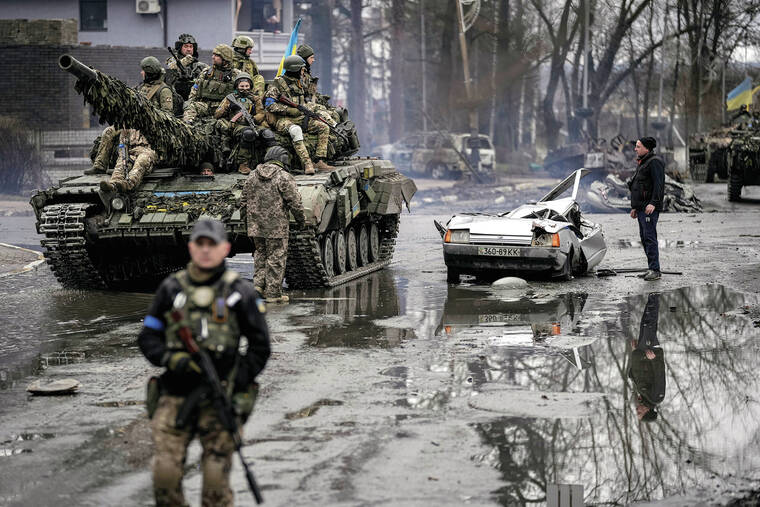West, Russia mull nuclear steps in a ‘more dangerous’ world
WASHINGTON — Russia’s assault on Ukraine and its veiled threats of using nuclear arms have policymakers, past and present, thinking the unthinkable: How should the West respond to a Russian battlefield explosion of a nuclear bomb?
The default U.S. policy answer, say some architects of the post-Cold War nuclear order, is with discipline and restraint. That could entail stepping up sanctions and isolation for Russian President Vladimir Putin, said Rose Gottemoeller, deputy secretary-general of NATO from 2016 to 2019.
ADVERTISING
But no one can count on calm minds to prevail in such a moment, and real life seldom goes to plan. World leaders would be angry, affronted, fearful. Miscommunication and confusion could be rife. Hackers could add to the chaos. Demands would be great for tough retaliation — the kind that can be done with nuclear-loaded missiles capable of moving faster than the speed of sound.
When military and civilian officials and experts have war-gamed Russian-U.S. nuclear tensions in the past, the tabletop exercises sometimes end with nuclear missiles arcing across continents and oceans, striking the capitals of Europe and North America, killing millions within hours, said Olga Oliker, program director for Europe and Central Asia at the International Crisis Group.
“And, you know, soon enough, you’ve just had a global thermonuclear war,” Oliker said.
It’s a scenario officials hope to avoid, even if Russia targets Ukraine with a nuclear bomb.
Gottemoeller, a chief U.S. nuclear negotiator with Russia for the Obama administration, said that the outlines that President Joe Biden has provided so far of his nuclear policy stick with those of past administrations in using atomic weapons only in “extreme circumstances.”
“And a single Russian nuclear use demonstration strike, or — as horrific as it would be — a nuclear use in Ukraine, I do not think would rise to that level” of demanding a U.S. nuclear response, said Gottemoeller, now a lecturer at Stanford University.
For former Sen. Sam Nunn, a Georgia Democrat who over nearly a quarter-century in Congress helped shape global nuclear policy, the option of Western nuclear use has to remain on the table.
“That’s what the doctrine of mutual assured destruction has been about for a long, long time,” said Nunn, now strategic adviser to the Nuclear Threat Initiative security organization, which he co-founded.
“If President Putin were to use nuclear weapons, or any other country uses nuclear weapons first, not in response to a nuclear attack, not in response to an existential threat to their own country … that leader should assume that they are putting the world in the high risk of a nuclear war, and nuclear exchange,” Nunn said.
For U.S. officials and world leaders, discussions of how to respond to a limited nuclear attack are no longer theoretical.
How to respond to any use by Russia of chemical, biological or nuclear weapons was among the issues discussed by Biden and other Western leaders when they met in Europe in late March. Three NATO members — the United States, Britain and France — have nuclear weapons.
One overarching concern is that by casting some nuclear weapons as tactical weapons to be used in battle, Russia could break the nearly eight-decade global taboo against using a nuclear weapon against another country. Even comparatively small tactical nuclear weapons approach the strength of the atomic bomb the United States dropped on Hiroshima, Japan, in World War II.
Gottemoeller and Nunn praise Biden’s restraint in the face of Putin’s implicit nuclear warnings at the outset of the war. Biden made no known move to raise the U.S. nuclear alert status. The U.S. also postponed a routine Minuteman III test launch last month to avoid escalating tensions.
But in the short term and long, the world appears more at risk of a nuclear conflict as a result of Putin’s bungled invasion and nuclear threats, according to arms control experts and negotiators.
The weaknesses that Russia’s invasion exposed in its conventional military forces may leave Putin feeling even more compelled in the future to threaten nuclear use as his best weapon against the far-stronger United States and NATO.
While Gottemoeller argued that Ukraine’s surrendering of its Soviet nuclear arsenal in 1994 opened the door for three decades of international integration and growth, she said some governments may take a different lesson from nuclear Russia’s invasion of non-nuclear Ukraine — that they need nuclear bombs as a matter of survival.


